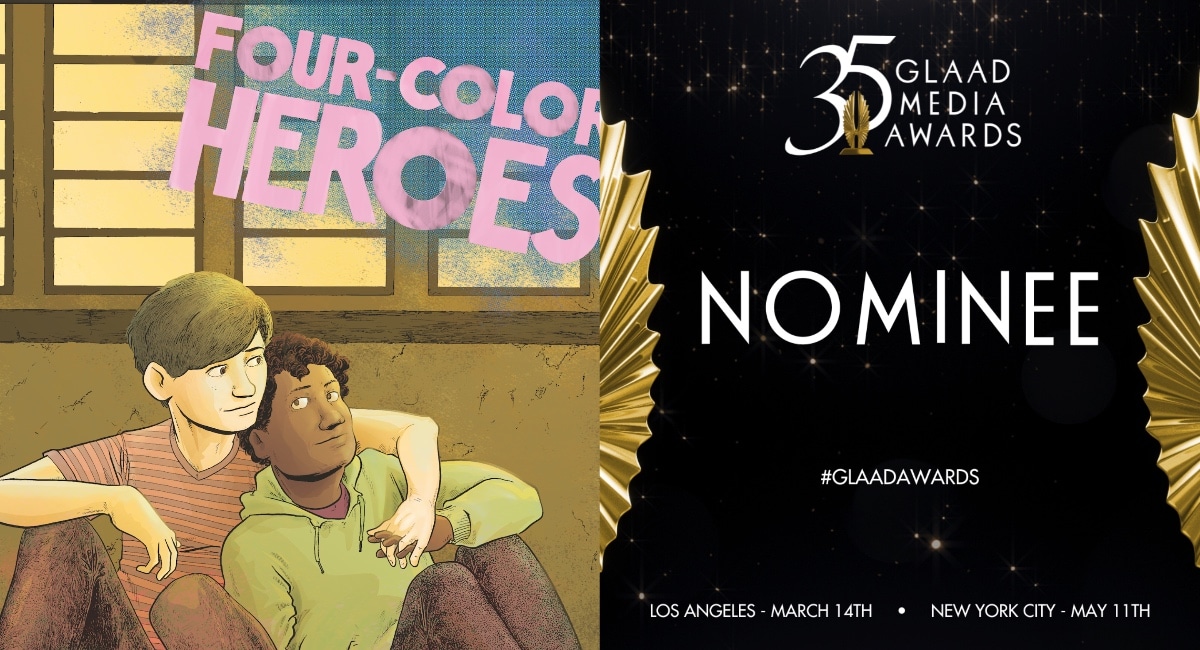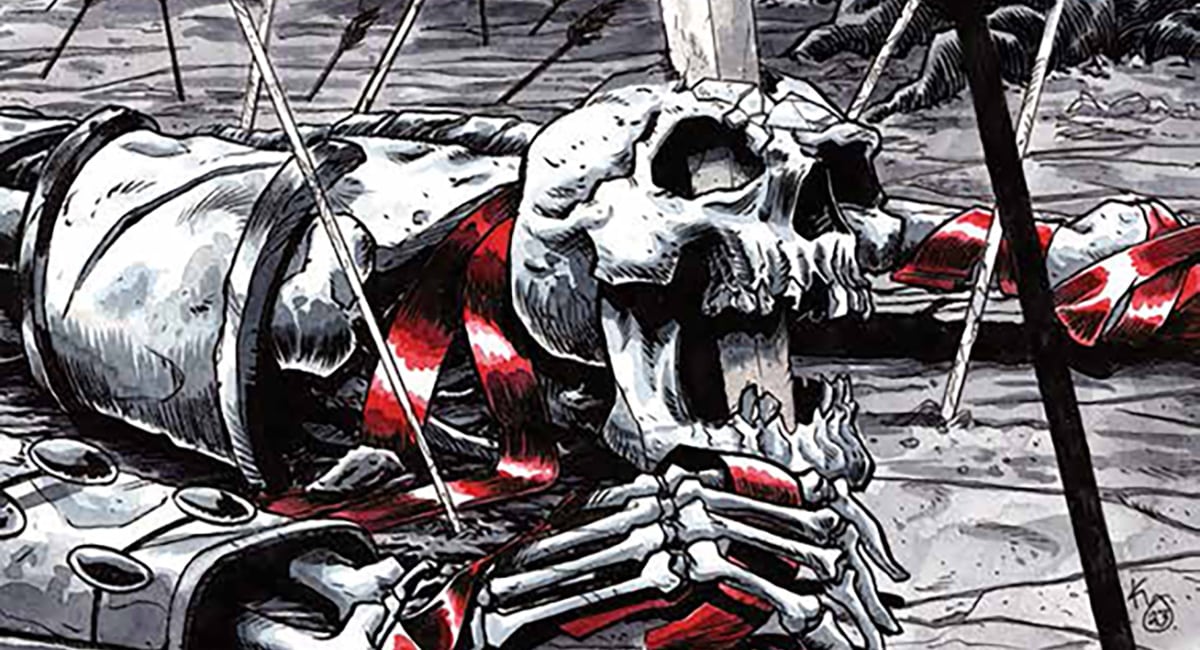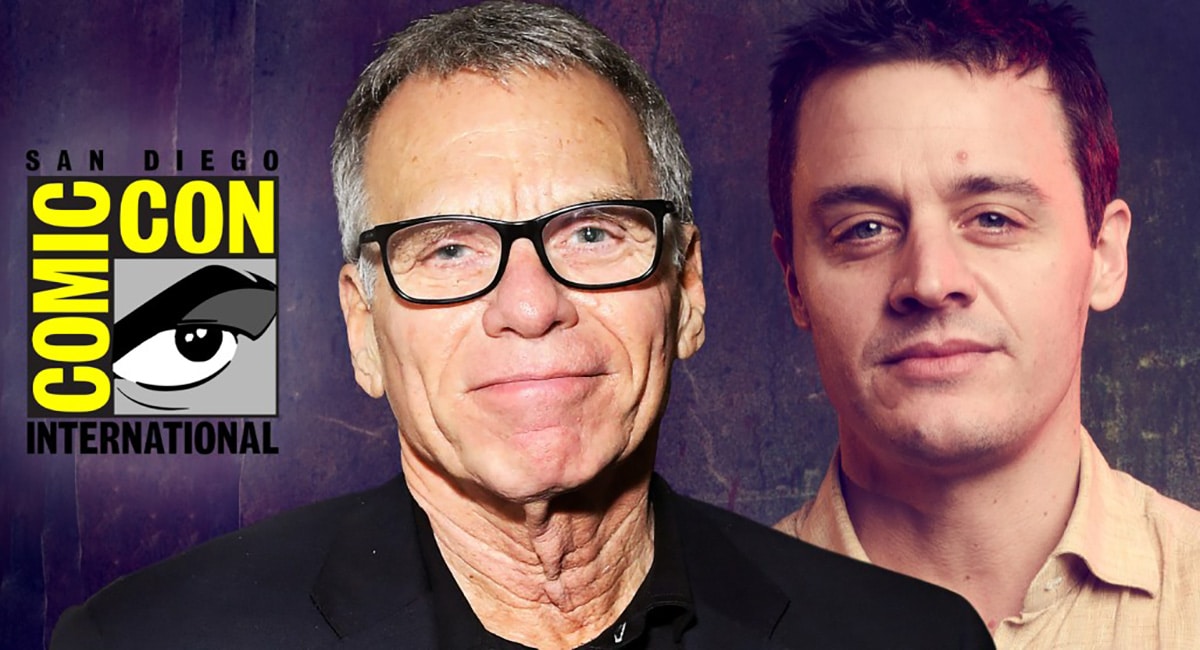With the GLAAD Media Award ceremonies around the corner, this week we’re focusing on Fanbase Press‘s GLAAD-nominated coming-of-age graphic novel Four-Color Heroes, written and illustrated by Aotearoa/New Zealand-born creator Richard Fairgray (Black Sand Beach). Announced in February 2024, Four-Color Heroes received a 35th Annual GLAAD Media Award nomination in the Outstanding Original Graphic Novel/Anthology category and is nominated against Blackward (Lawrence Lindell), Carmilla: The First Vampire (Amy Chu/Soo Lee/Sal Cipriano), Cosmoknights Book Two (Hannah Templer), Heartstopper Vol. 5 (Alice Oseman), Light Carries On (Ray Nadine), Northranger (Rey Terciero/Bre Indigo), Parallel (Matthias Lehmann), Roaming (Jillian Tamaki/Mariko Tamaki), and Us (Sara Soler/Joamette Gil).
Set in a New Zealand high school in 2004, the year the nation passed the Civil Union Act establishing civil unions for same-sex couples, two students explore their identity and what it means socially. If there’s any question that this is a queer book, look no further than the first-page discussion about “being an egg.” (Later ROK — I’m still thinking about eggs, and that’s not meant to be trite.)
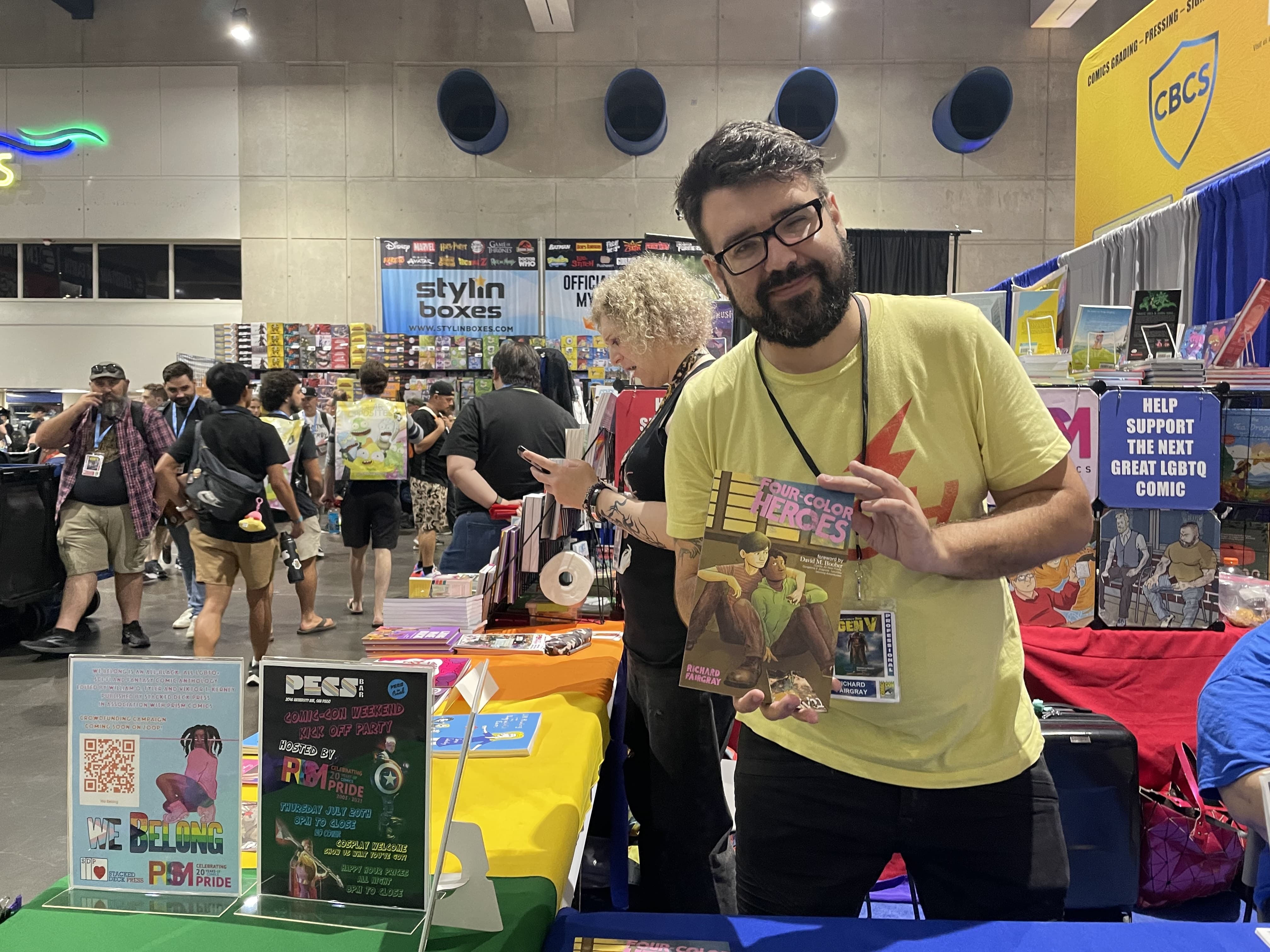
In September 2023, Fanbase Press announced the digital release of the te reo Māori translation of Four-Color Heroes, timed with Māori Language Week, an event held in New Zealand since 1975 to celebrate the dynamic and living language. “In light of Richard’s New Zealand roots, it was vital for us to not only celebrate the indigenous language of the country, but to engage in the Māori Language Week theme of ‘making the language stronger,'” noted Fanbase Press Editor-in-Chief Barbra Dillon. “We were honored to partner with New Zealand-based Komako A. Silver and Alejandra Jensen (The Art of Taonga Puoro) for the translation and incredibly appreciative of their thoughtfulness and expertise throughout the process.”
The Beat caught up with Fanbase Press creator Richard Fairgray to discuss how graphic novels play a crucial role in representing mental health issues in the LGBTQIA+ community and offer a unique platform for creators to push boundaries and explore more mature themes.
REBECCA OLIVER KAPLAN: There’s a higher incidence of mental health issues in the LGBTQ+ community. Why is it important to highlight that through comics?
RICHARD FAIRGRAY: I think that so often, queer representation in comics is limited to either extreme positivity or extreme negativity. And I think that when you are a group of people who have been kicked out of the free house all your lives, you want to find a new free house, and when that new free house only has two options, it becomes equally as limiting. So I try to create books that offer things across a broad spectrum of material for kids who never find true happiness or the absolute best thing about, like, “Hey, if you come out, everything will be great.” They get to be on a journey of self-discovery and cut it off at the point where they are somewhere, but the ending is open. I think that a lot of people will see that in this book, and I think that kind of representation matters
KAPLAN: Why do you think graphic novels are a good place to share this type of story?
FAIRGRAY: It’s the only medium that you can control time. You can make someone feel like you’re spending more time with characters or less time, depending on the number of panels you use when you put the page turn and how detailed the art is. I think that it creates a sense of immediacy, where you are reading something held in place by the author, also you are imagining the voices that you’re hearing in your head rather than having someone else’s interpretation. So it’s like the strange push and pull always in place between the creator and the reader.
KAPLAN: Awesome. What age range is this book?
FAIRGRAY: The publisher is saying anyone 16 and up. I honestly think anyone 12 and up, if they’re a good reader. I would have benefited if I’d had this book when I was 12 or 13. I think many adults are reading it now who keep messaging me, telling me that it made them cry, so I don’t know if there’s a specific age range. If I’d had it when I was 12, it would have made me feel a lot more included.
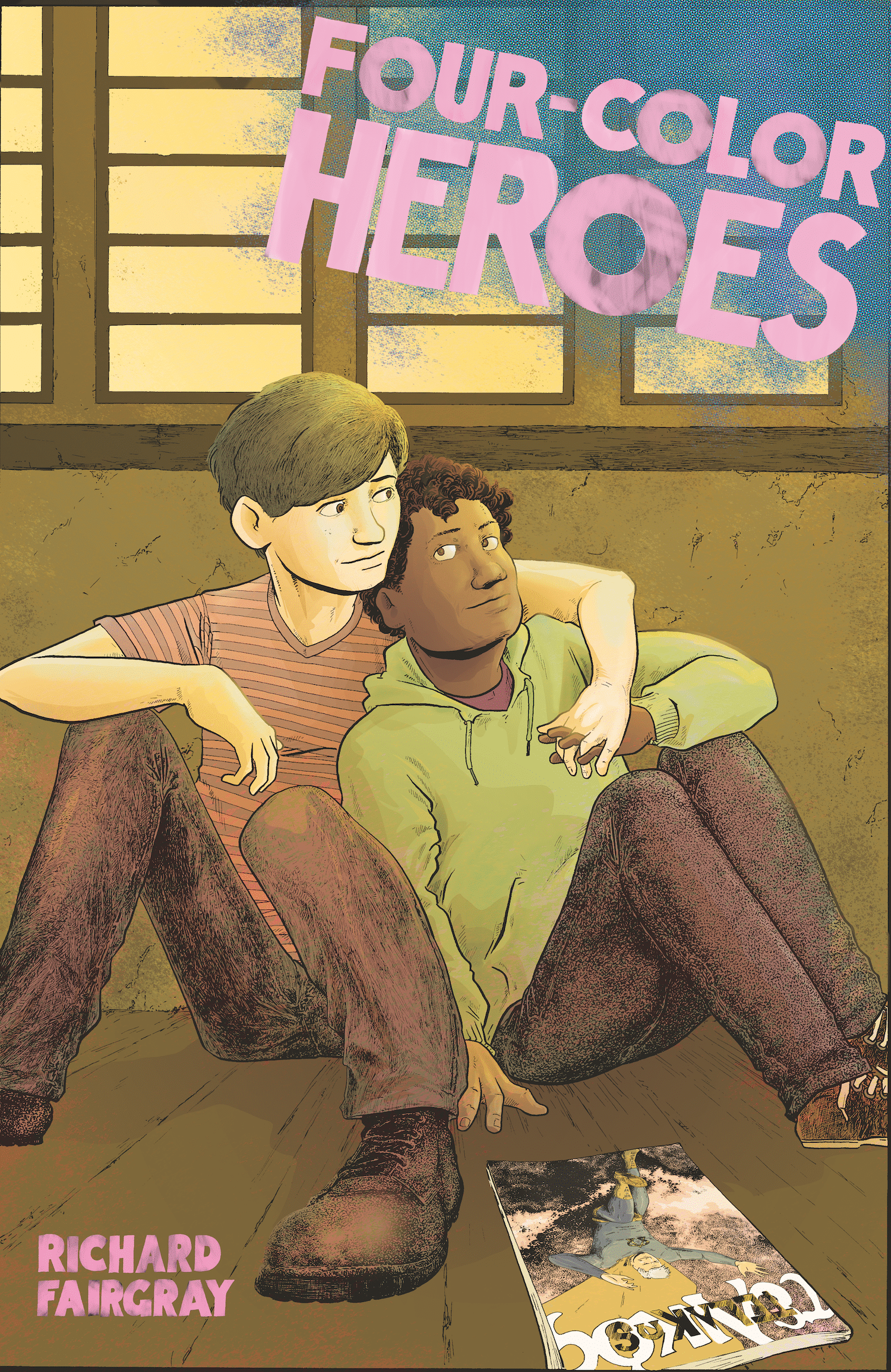
KAPLAN: Can you tell me more about that fan reaction?
FAIRGRAY: I am getting many people saying that they picked up the book, or they’ve been sent it for review, or whatever, and they’ve never read a comic before. and they think. “Oh, I’ll just read a chapter of this.” Then, they find themselves crying in their car an hour later, unable to put the book down. I’m not trying to subvert some genre here. I’m just giving this very earnest story that I’ve had for so long, and I’m hoping that maybe because it’s been in my head for so long, it’s connecting to people because I know every nuance. Maybe it’s also because I drew in a more realistic style—it makes people feel like they’re really seeing themselves. I don’t really have an answer at all. All I know is it chokes me up to hear that this book is just touching someone.
KAPLAN: Why did you switch from kids comics to more adult work?
FAIRGRAY: At the beginning of COVID-19, I started working on a memoir when everyone else was baking bread. I’ve been doing kids’ books for about ten years and started making this memoir. It’s very honest and revealing, probably a big overshare of a story about 18 months of my life that was massive. My agent saw it and said it would end my career if I ever released it. I didn’t release it; I was a good boy and held it back. And then, I just kept making more and more adult stuff to see how far I could push it, like what I was allowed to do. Until the beginning of this year, when I thought, “If I wanted to do this for the money, I would just be a professional basketball player or whatever else makes a lot of money.”
Now, I’m making comics because I like pushing the boundaries with storytelling, so I put out the memoir, and my career was fine. I put out this book like a big farewell to show that I am moving away from kid-friendly stuff to do my more adult stuff like Haunted Hill and Octopus: A Memoir of Flailing. This is petty, but I will say it: it’s not because I couldn’t do it. Four-Colour Heroes is this ultimate representation that I can do every single part.
I don’t know if I’ve stopped making children’s books forever. Right now, I’m not interested because when working with kids’ books, there are too many limitations on the kinds of stories I get to tell. Fanbase Press is wonderful at letting me tell whatever story I want. Still, I may come back to kids’ books later when the market changes or when publishers change their minds, or when I’ve proven that I can do all these other things.
Visit www.FourColorHeroes.com or www.fanbasepress.com to learn more about Four-Colour Heroes, as well as Facebook (/FourColorHeroes) and Twitter, @4ColorHeroesGN.


